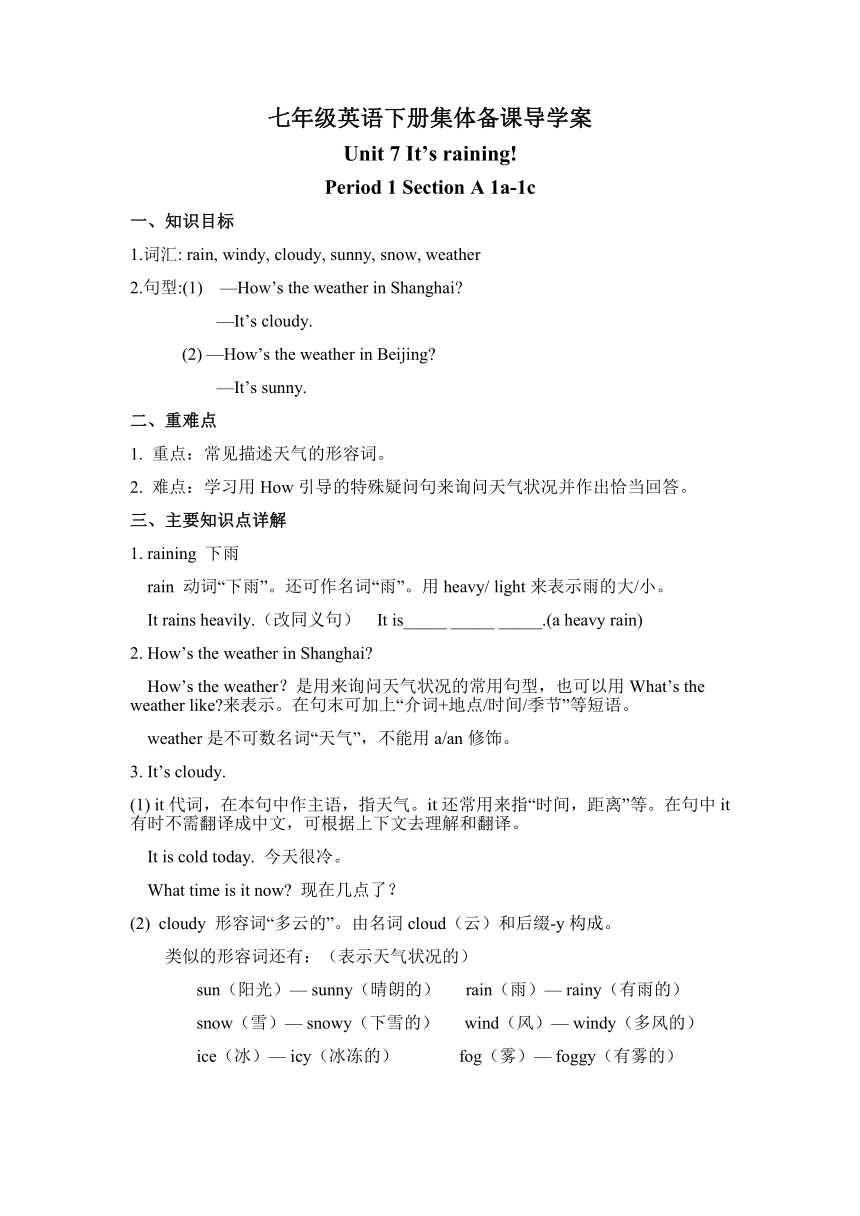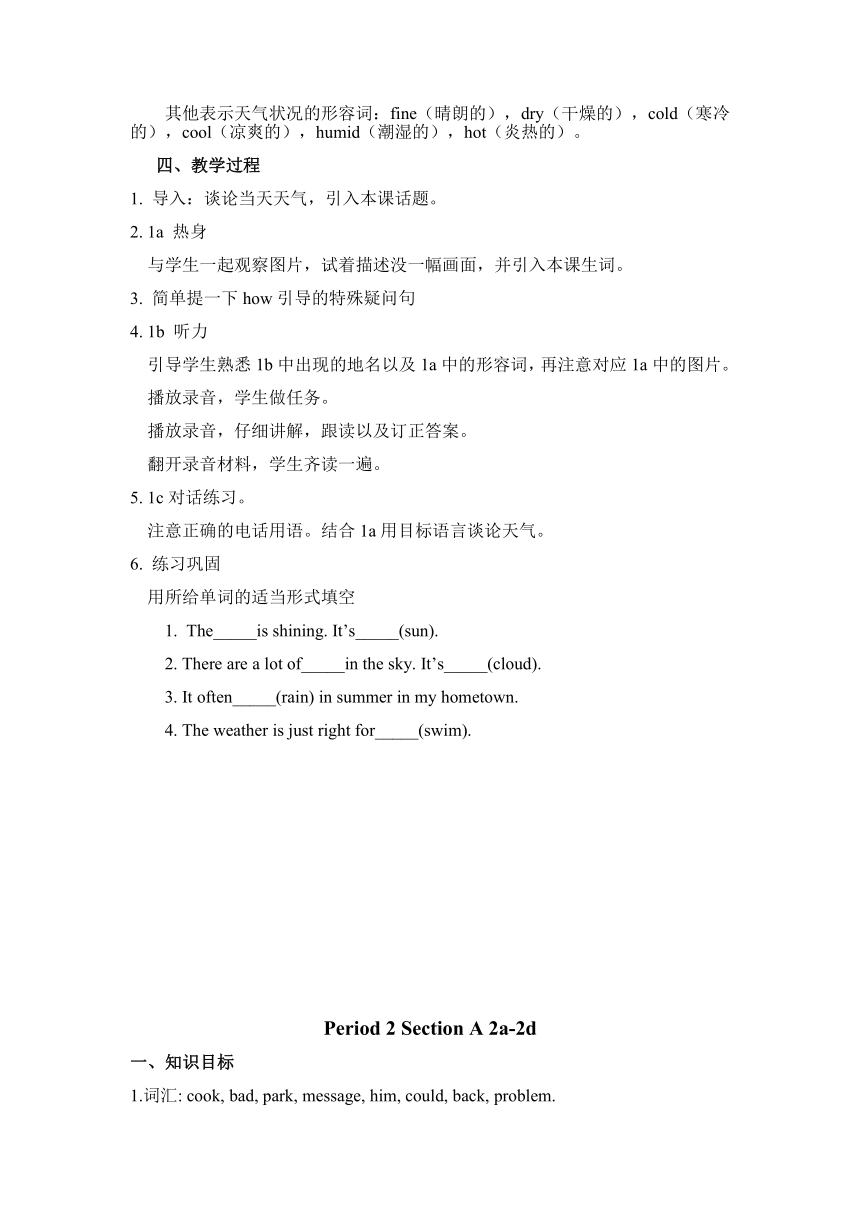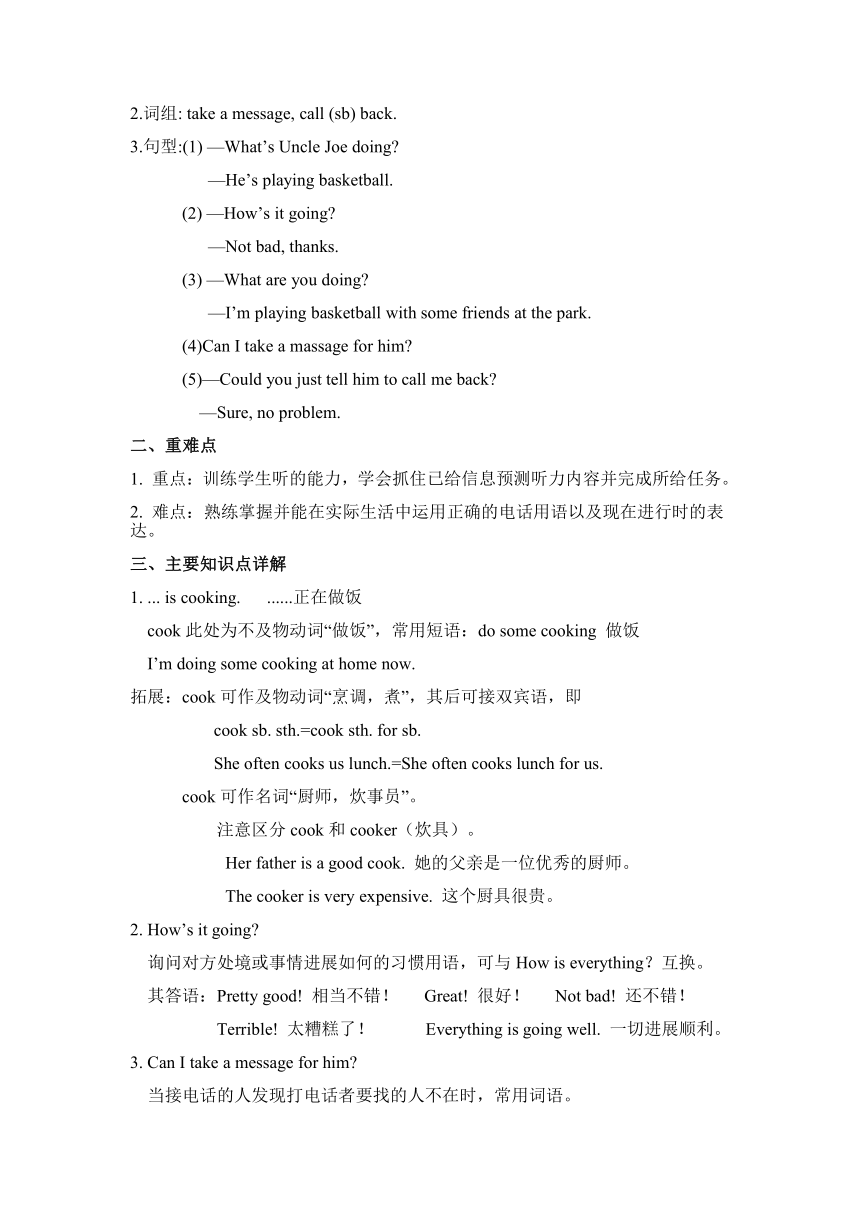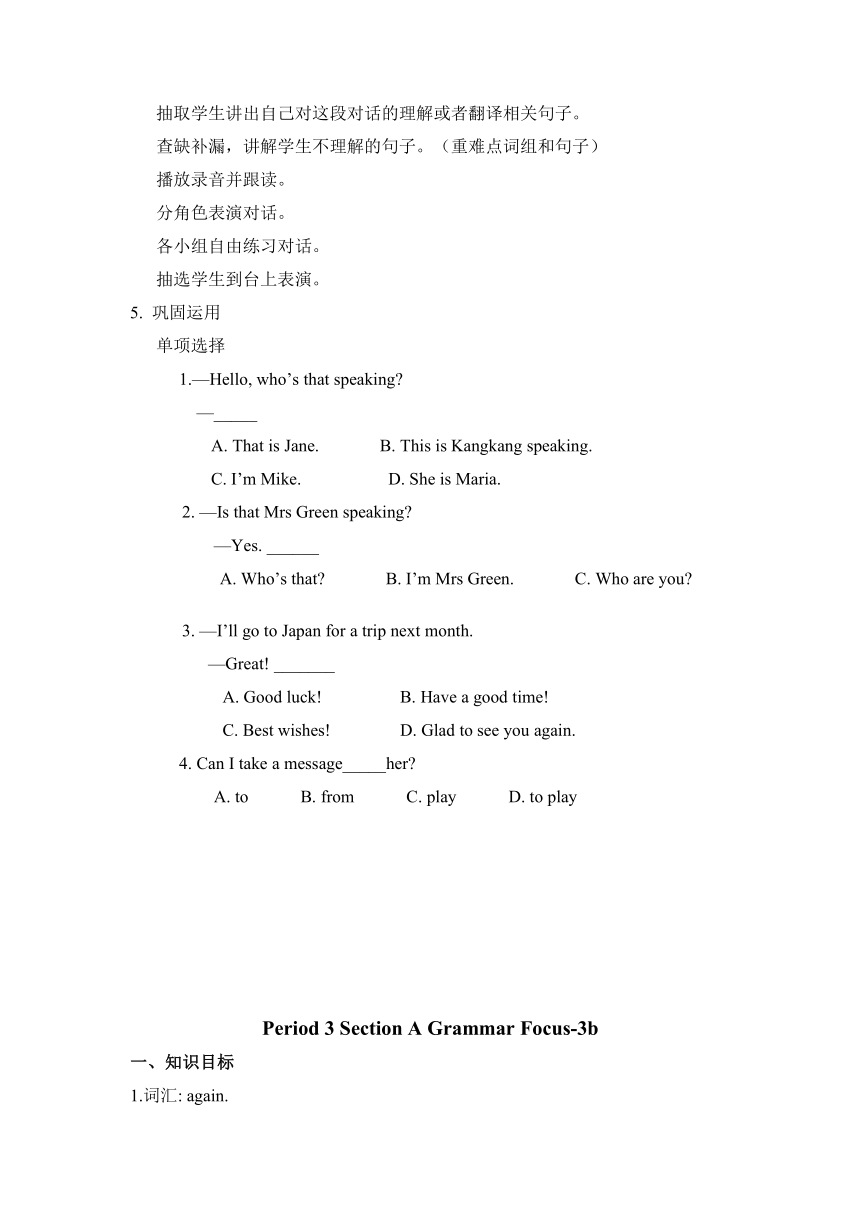Unit 7 It’s raining!集体备课 导学案(无答案)
文档属性
| 名称 | Unit 7 It’s raining!集体备课 导学案(无答案) |  | |
| 格式 | zip | ||
| 文件大小 | 54.5KB | ||
| 资源类型 | 教案 | ||
| 版本资源 | 人教新目标(Go for it)版 | ||
| 科目 | 英语 | ||
| 更新时间 | 2019-06-25 14:05:59 | ||
图片预览





文档简介
七年级英语下册集体备课导学案
Unit 7 It’s raining!
Period 1 Section A 1a-1c
一、知识目标
1.词汇: rain, windy, cloudy, sunny, snow, weather
2.句型:(1) —How’s the weather in Shanghai?
—It’s cloudy.
(2) —How’s the weather in Beijing?
—It’s sunny.
二、重难点
1. 重点:常见描述天气的形容词。
2. 难点:学习用How引导的特殊疑问句来询问天气状况并作出恰当回答。
三、主要知识点详解
1. raining 下雨
rain 动词“下雨”。还可作名词“雨”。用heavy/ light来表示雨的大/小。
It rains heavily.(改同义句) It is_____ _____ _____.(a heavy rain)
2. How’s the weather in Shanghai?
How’s the weather?是用来询问天气状况的常用句型,也可以用What’s the weather like?来表示。在句末可加上“介词+地点/时间/季节”等短语。
weather是不可数名词“天气”,不能用a/an修饰。
3. It’s cloudy.
(1) it代词,在本句中作主语,指天气。it还常用来指“时间,距离”等。在句中it有时不需翻译成中文,可根据上下文去理解和翻译。
It is cold today. 今天很冷。
What time is it now? 现在几点了?
(2) cloudy 形容词“多云的”。由名词cloud(云)和后缀-y构成。
类似的形容词还有:(表示天气状况的)
sun(阳光)— sunny(晴朗的) rain(雨)— rainy(有雨的)
snow(雪)— snowy(下雪的) wind(风)— windy(多风的)
ice(冰)— icy(冰冻的) fog(雾)— foggy(有雾的)
其他表示天气状况的形容词:fine(晴朗的),dry(干燥的),cold(寒冷的),cool(凉爽的),humid(潮湿的),hot(炎热的)。
四、教学过程
1. 导入:谈论当天天气,引入本课话题。
2. 1a 热身
与学生一起观察图片,试着描述没一幅画面,并引入本课生词。
3. 简单提一下how引导的特殊疑问句
4. 1b 听力
引导学生熟悉1b中出现的地名以及1a中的形容词,再注意对应1a中的图片。
播放录音,学生做任务。
播放录音,仔细讲解,跟读以及订正答案。
翻开录音材料,学生齐读一遍。
5. 1c对话练习。
注意正确的电话用语。结合1a用目标语言谈论天气。
6. 练习巩固
用所给单词的适当形式填空
1. The_____is shining. It’s_____(sun).
2. There are a lot of_____in the sky. It’s_____(cloud).
3. It often_____(rain) in summer in my hometown.
4. The weather is just right for_____(swim).
Period 2 Section A 2a-2d
一、知识目标
1.词汇: cook, bad, park, message, him, could, back, problem.
2.词组: take a message, call (sb) back.
3.句型:(1) —What’s Uncle Joe doing?
—He’s playing basketball.
(2) —How’s it going?
—Not bad, thanks.
(3) —What are you doing?
—I’m playing basketball with some friends at the park.
(4)Can I take a massage for him?
(5)—Could you just tell him to call me back?
—Sure, no problem.
二、重难点
1. 重点:训练学生听的能力,学会抓住已给信息预测听力内容并完成所给任务。
2. 难点:熟练掌握并能在实际生活中运用正确的电话用语以及现在进行时的表达。
三、主要知识点详解
1. ... is cooking. ......正在做饭
cook此处为不及物动词“做饭”,常用短语:do some cooking 做饭
I’m doing some cooking at home now.
拓展:cook可作及物动词“烹调,煮”,其后可接双宾语,即
cook sb. sth.=cook sth. for sb.
She often cooks us lunch.=She often cooks lunch for us.
cook可作名词“厨师,炊事员”。
注意区分cook和cooker(炊具)。
Her father is a good cook. 她的父亲是一位优秀的厨师。
The cooker is very expensive. 这个厨具很贵。
2. How’s it going?
询问对方处境或事情进展如何的习惯用语,可与How is everything?互换。
其答语:Pretty good! 相当不错! Great! 很好! Not bad! 还不错!
Terrible! 太糟糕了! Everything is going well. 一切进展顺利。
3. Can I take a message for him?
当接电话的人发现打电话者要找的人不在时,常用词语。
message 可数名词“消息,信息”
take a message for sb “为某人捎个口信”
give sb a message 捎信给某人
leave a message 留口信
I’m sorry, she’s out right now. Can I take a message?
4. Could you just tell him to call me back?
could 情态动词“能,可以”,表请求许可,比can委婉。
tell sb (not) to do sth 告诉某人(不要)做某事
tell sb sth 告诉某人某事
tell sb about sth 告诉某人关于某事
5. Sure, no problem.
辨析problem与question
problem:指说话者认为难以解决的问题或用于数学或物理的习题。
Can you work out this math problem?你能算出这道数学题吗?
指困难、麻烦,have a problem doing sth. 做某事有困难
We have problems getting there. 我们到达那儿有许多困难。
question:指说话者需要寻找答案的问题,它常与动词ask或answer连用。
May I ask you some questions? 我能问你一些问题吗?
四、教学过程
1. 教授本课新词。
2. 2a,2b 听力
提示学生注意观察2a图中人物的性别长幼以及他们正在做的事情。
播放录音,给图片排序。
播放录音,订正答案。(基础好的同学可顺便完成2b的搭配)
播放录音,完成2b,订正答案。
跟着录音读,再翻开录音材料全班分角色齐读。
3. 2c 小组对话练习
在2a和2b的基础上,根据2c所给的句型,小组对话并在班上展示。
4. 2d 分角色表演对话
学生自己快速完成句子的翻译、划生词。(3分钟)
抽取学生讲出自己对这段对话的理解或者翻译相关句子。
查缺补漏,讲解学生不理解的句子。(重难点词组和句子)
播放录音并跟读。
分角色表演对话。
各小组自由练习对话。
抽选学生到台上表演。
5. 巩固运用
单项选择
1.—Hello, who’s that speaking?
—_____
A. That is Jane. B. This is Kangkang speaking.
C. I’m Mike. D. She is Maria.
2. —Is that Mrs Green speaking?
—Yes. ______
A. Who’s that? B. I’m Mrs Green. C. Who are you?
3. —I’ll go to Japan for a trip next month.
—Great! _______
A. Good luck! B. Have a good time!
C. Best wishes! D. Glad to see you again.
4. Can I take a message_____her?
A. to B. from C. play D. to play
Period 3 Section A Grammar Focus-3b
一、知识目标
1.词汇: again.
2.句型:(1) —How’s the weather?
—It’s cloudy/ sunny/ rainy/ snowy.
(2) —How’s it going?
—Not bad/ Great/ Terrible.
(3) —What are they doing?
—They’re playing basketball in the park.
(4) —What are you doing?
—I’m cooking.
(5)—What’s he doing?
—He’s studying at his friend’s home.
二、重难点
1. 重点:熟练运用How引导的特殊疑问句来询问天气状况并作出恰当回答。掌握并熟练运用现在进行时态的基本句型。
2. 难点:现在进行时态的与一般现在时态的比较运用。
三、主要知识点详解
1. 谈论天气的常用语
How’s the weather today?
What’s the weather like today?
It’s sunny/ rainy/ snowy/ windy…
It’s raining/snowing.
It’s going to rain/snow.
2. how引导的特殊疑问句
(1) how用来询问方式或手段
—How do you go to work? —By bus.
(2) how用于问候
—How are you? —I’m fine. Thank you.
(3) how用于询问天气
—How’s the weather? —It’s sunny.
(4) how用于询问价格
—How much is the shirt? —It’s fifty yuan.
(5) how用于询问数量
How many对可数名词的数量提问,How much对不可数名词的数量提问。
—How many books do you have? —I have ten books.
—How much meat do you want? —Two kilos.
(6) how about用于征求意见,后接名词、代词或动名词。
How about playing soccer?
How about this one?
3. 现在进行时常用的时间状语及提示语
句中有now, at present, at this moment等或有look, listen等提示语时,常用现在进行时态。
What are they doing these days?
4. 现在进行时的基本用法总结
(1)表示说话时动作正在发生或进行。They are playing basketball now.
(2)表示现阶段正在进行的动作或发生的事。
They are working hard at their lessons this year.
(3)有些动词的现在进行时用来表示按计划或安排将要进行的动作。常用的动词有:come, go, arrive, leave, start, stay等。
Don’t worry. The train is coming soon. 别着急,火车很快就来。
He is coming back tomorrow. 他明天就回来了。
(4)现在进行时和always等副词连用表示反复出现的问题,常带有不赞赏、不满等感彩。
He is always late for school.
注意:有些动词如know, have, like, love, want, hope等,通常不用于进行时。
Lucy wants to go home.
I like playing volleyball.
5. What’s John doing right now?
right now“现在,此刻”,相当于at the moment或now,通常和现在进行时态连用。
He is my favorite star right now.
right now其他含义:“立刻,马上”,此时通常和一般将来时连用。
I’ll do it right now. 我马上做。
四、教学过程
1. Grammar Focus
学生自己观察表格中的句子,分小组讨论并给出语法规律。(how疑问句和现在进行时态的基本句型)
教师做语法知识的补充。
2. 3a 选词填空(恰当形式)并练习对话。
学生自主完成习题,组内成员可互相讨论答案。
各组展示最终答案。
教师讲解订正答案。
3. 3b 根据图片提示填写表格。
让学生自己组内讨论并确定最终答案。
选代表到黑板前写出本组的答案。
教师讲解订正。
4. 补充练习
1.—Hello! Is that Mr. Wang speaking?
—Yes.________
A. Who’s that? B. Who are you?
C. I’m speaking. D. I’m Mr. Wang.
2.What_____they_____every evening?
3. It’s cold and windy today.(对划线部分提问)
_____ _____ _____today?
4. My mom is cooking.(对划线部分提问)
_____ _____ _____mom_____?
Period 4 Section B 1a-1e
一、知识目标
1.词汇: dry, cold, hot, warm.
2.句型:(1) —How’s the weather in picture d?
—It’s dry.
(2) —How’s it going?
—Not too bad!
二、重难点
1. 重点:培养学生听的能力,养成记关键词的好习惯。
2. 难点:能够流利的使用目标语言表达天气状况。
三、主要知识点详解
cold 形容词“寒冷的”
辨析cold与cool
cold:作形容词意为“冷的”,名词“伤风,感冒”,反义词为“hot”
It’s a cold winter. 这是一个寒冷的冬天。
She is in bed with a cold. 她因感冒而卧床。
cool:作形容词意为“凉爽的”,作为流行语意为“酷”,反义词“warm”
It’s very cool today. 今天天气很凉爽。
I like Liu Qian. He is very cool. 我喜欢刘谦。他太酷了。
四、教学过程
1. 1a 搭配单词与图片
教师引导学生看图片,用英语作简单的表述。
学生自己完成词和图的搭配。
订正答案。
2. 根据1b句型和1a的图片内容练习问答。
3. 1c, 1d 和1e 听力
教师引导学生看1c表格中的关键词,明确题目要求,预测听力内容。
播放录音,学生完成表格填空。(如不能完成,再播放一遍录音)
播放录音,边听边讲解重难点句子并订正答案。
跟着录音读,然后学生分角色朗读录音材料。
根据表格中的信息和1e的提示编对话。
4. 练习巩固
1. What’s the weather like today? (同义句改写)
_____ _____the weather today?
2. —______the weather like last Monday?(单项选择)
—It was sunny.
A. How was B. What’s C. What was D. How is
3. The weather in Guangzhou_____hot and humid.
A. is B. are C. be D. Am
4. When the sun is shining(照耀), it’s a _____day.
A. wind B. sunny C. cloudy D. cold
Period 5 Section B 2a-2c
一、知识目标
1.词汇: visit, Canada, summer, sit, juice, soon, vacation, hard, Europe, mountain, country.
2.句型:(1) I’m so happy to see them again.
(2) Are you studying hard, or are you having fun?
(3) My family and I are on a vacation in the mountains.
(4) I want to call you but my phone isn’t working, so I’m writing to you.
(5) It’s hot in your country now, isn’t it?
二、重难点
1. 重点:培养阅读技巧,了解撰写明信片的格式与方法。
2. 难点:书面文体——明信片的实际应用。
三、主要知识点详解
1. I’m so happy to see them again. 再次见到他们我是如此高兴。
be happy to do sth. 高兴做某事
2.Are you studying hard, or are you having fun?你在努力学习吗?或者是玩得很愉快?
(1)study hard的用法:动词短语“努力工作,努力学习”,其中hard做副词“努力地,刻苦地”,用来修饰动词。
work hard 努力工作 try hard努力 swim hard努力游
hard的其他用法:作形容词“难的,困难的,艰苦的”,同义词“difficult”
(2)have fun的用法:表示“过得高兴,玩得愉快”,fun为不可数名词,前面不用a/an。have fun相当于have a good time/ enjoy oneself, 其后可接doing sth, 表示“愉快地做某事,高兴地做某事”。
Did you have fun at the party?
I have great fun collecting stamps.
I have fun playing games.
3. My family and I are on a vacation in the mountains. 我和我的家人正在山里度假。
句中and链接两个并列主语,谓语动词用复数,但and所连接的并列主语是同一个人、事物或概念时,谓语动词用单数。
Zhang Tao and I are both students. 张涛和我都是学生。
The writer and teacher is coming. 那位作家兼教师来了。
on a vacation “在度假”,相当于“on a holiday“
go on a vacation 去度假
summer vacation/ holiday 暑假 winter vacation/ holiday 寒假
辨析vacation与holiday
vacation:“假期”,指放下工作和学习的一段较长的休息时间,常可用holiday替换。
holiday:“假日,休息日”,主要指按风俗习惯或法律规定的纪念日或休息日,在英式英语中,其复数形式可表示延续一段时间的“假期”,美式英语则习惯用单数。
辨析mountain与hill
mountain:指陡峭连绵的高山
hill:指较低矮的小山或丘林
4. It’s hot in your country now, isn’t it? 现在你的国家天气炎热,不是吗?
本句是一个反义疑问句,表示提出情况或看法,问对方同意与否。这种问句都由两部分组成,前一部分为陈述形式,后一部分为简短问句。如果前一部分为肯定形式,后一部分通常用否定形式,而且后一部分的主谓与前一部分的主谓在人称、时态和数上要保持一致。
Your mother goes to work every day, doesn’t she? 你妈妈每天都去上班,不是吗?
It’s a nice day, isn’t it? 今天天气很好,不是吗?
反义疑问句三要点:前后谓语正相反;短句not如出现,必须缩写是习惯;最后一点应注意,短句主语代词填。
4、教学过程
1. 2a 用“How’s the weather?/ What are the people doing?”谈论2a的图片。
2. 2b 明信片
询问学生对明信片的了解,教师做相应补充。
学生自主看两张明信片里的内容,划出生词,不懂的句子。(可小组讨论)
教授生词,并放到文中去理解。
分析和讲解重难点句子。
谈谈写明信片的格式与方法,了解明信片的实际应用。
听录音,跟读。
全班齐读一遍,教师指点。
3. 2c 根据2b的内容填写表格。
学生先自己完成,然后小组讨论答案。
各组代表分享答案,并分享找到答案的方法。
教师做点评并订正答案。
4. 练习巩固
阅读短文,根据短文内容和首字母提示填词。
Today is Sunday. It’s a beautiful, s__1__day! Mary and her f__2__ are going to the West Hill for a picnic(野餐). They take some food w 3 them. Now they get to a quiet p 4 on the hill(小山). There are many flowers and green g 5 here. They are singing, talking, e 6 and drinking. Everyone is h 7 a good time.
Period 6 Section B 3a-Self Check
一、知识目标
1.词汇: skate, snowy, winter, Russian, snowman, rainy
2.句型: (1) People are wearing hats and sweaters, but they’re having fun.
(2) One girl is skating on a river and a man is taking a photo of a snowman.
二、重难点
1. 重点:培养写作技巧,掌握正确撰写明信片的方法。
2. 难点:明信片的实际应用,能够撰写明信片。
三、主要知识点详解
One girl is skating on a river and a man is taking a photo of a snowman.
take a photo of的用法
take a photo of或take photos of是动词短语“给... 照相”,photo也可用picture替换。
Can you take a photo/picture of the park for me?
Can we take a photo/picture with you, please?
4、教学过程
1. 教授生词skate~rainy
2. 3a 选词填空
学生独立完成练习。
教师讲解并订正答案。
3. 3b和3c 明信片的书写
总结撰写明信片的格式:称呼,标点符号,板式,落款以及常用的结束语。
让学生根据自己的经历试着一一回答所列出的问题。
根据所给问题提示撰写明信片,提示学生注意格式。
选择写得最快的两三位学生的作文在上进行点评(鼓励并指出需要改进的地方)。
给出评分标准,让组内同学互评作文。
4. Self Check
学生自主完成练习。
教师进行选择性的讲解并给出正确的答案。
Unit 7 It’s raining!
Period 1 Section A 1a-1c
一、知识目标
1.词汇: rain, windy, cloudy, sunny, snow, weather
2.句型:(1) —How’s the weather in Shanghai?
—It’s cloudy.
(2) —How’s the weather in Beijing?
—It’s sunny.
二、重难点
1. 重点:常见描述天气的形容词。
2. 难点:学习用How引导的特殊疑问句来询问天气状况并作出恰当回答。
三、主要知识点详解
1. raining 下雨
rain 动词“下雨”。还可作名词“雨”。用heavy/ light来表示雨的大/小。
It rains heavily.(改同义句) It is_____ _____ _____.(a heavy rain)
2. How’s the weather in Shanghai?
How’s the weather?是用来询问天气状况的常用句型,也可以用What’s the weather like?来表示。在句末可加上“介词+地点/时间/季节”等短语。
weather是不可数名词“天气”,不能用a/an修饰。
3. It’s cloudy.
(1) it代词,在本句中作主语,指天气。it还常用来指“时间,距离”等。在句中it有时不需翻译成中文,可根据上下文去理解和翻译。
It is cold today. 今天很冷。
What time is it now? 现在几点了?
(2) cloudy 形容词“多云的”。由名词cloud(云)和后缀-y构成。
类似的形容词还有:(表示天气状况的)
sun(阳光)— sunny(晴朗的) rain(雨)— rainy(有雨的)
snow(雪)— snowy(下雪的) wind(风)— windy(多风的)
ice(冰)— icy(冰冻的) fog(雾)— foggy(有雾的)
其他表示天气状况的形容词:fine(晴朗的),dry(干燥的),cold(寒冷的),cool(凉爽的),humid(潮湿的),hot(炎热的)。
四、教学过程
1. 导入:谈论当天天气,引入本课话题。
2. 1a 热身
与学生一起观察图片,试着描述没一幅画面,并引入本课生词。
3. 简单提一下how引导的特殊疑问句
4. 1b 听力
引导学生熟悉1b中出现的地名以及1a中的形容词,再注意对应1a中的图片。
播放录音,学生做任务。
播放录音,仔细讲解,跟读以及订正答案。
翻开录音材料,学生齐读一遍。
5. 1c对话练习。
注意正确的电话用语。结合1a用目标语言谈论天气。
6. 练习巩固
用所给单词的适当形式填空
1. The_____is shining. It’s_____(sun).
2. There are a lot of_____in the sky. It’s_____(cloud).
3. It often_____(rain) in summer in my hometown.
4. The weather is just right for_____(swim).
Period 2 Section A 2a-2d
一、知识目标
1.词汇: cook, bad, park, message, him, could, back, problem.
2.词组: take a message, call (sb) back.
3.句型:(1) —What’s Uncle Joe doing?
—He’s playing basketball.
(2) —How’s it going?
—Not bad, thanks.
(3) —What are you doing?
—I’m playing basketball with some friends at the park.
(4)Can I take a massage for him?
(5)—Could you just tell him to call me back?
—Sure, no problem.
二、重难点
1. 重点:训练学生听的能力,学会抓住已给信息预测听力内容并完成所给任务。
2. 难点:熟练掌握并能在实际生活中运用正确的电话用语以及现在进行时的表达。
三、主要知识点详解
1. ... is cooking. ......正在做饭
cook此处为不及物动词“做饭”,常用短语:do some cooking 做饭
I’m doing some cooking at home now.
拓展:cook可作及物动词“烹调,煮”,其后可接双宾语,即
cook sb. sth.=cook sth. for sb.
She often cooks us lunch.=She often cooks lunch for us.
cook可作名词“厨师,炊事员”。
注意区分cook和cooker(炊具)。
Her father is a good cook. 她的父亲是一位优秀的厨师。
The cooker is very expensive. 这个厨具很贵。
2. How’s it going?
询问对方处境或事情进展如何的习惯用语,可与How is everything?互换。
其答语:Pretty good! 相当不错! Great! 很好! Not bad! 还不错!
Terrible! 太糟糕了! Everything is going well. 一切进展顺利。
3. Can I take a message for him?
当接电话的人发现打电话者要找的人不在时,常用词语。
message 可数名词“消息,信息”
take a message for sb “为某人捎个口信”
give sb a message 捎信给某人
leave a message 留口信
I’m sorry, she’s out right now. Can I take a message?
4. Could you just tell him to call me back?
could 情态动词“能,可以”,表请求许可,比can委婉。
tell sb (not) to do sth 告诉某人(不要)做某事
tell sb sth 告诉某人某事
tell sb about sth 告诉某人关于某事
5. Sure, no problem.
辨析problem与question
problem:指说话者认为难以解决的问题或用于数学或物理的习题。
Can you work out this math problem?你能算出这道数学题吗?
指困难、麻烦,have a problem doing sth. 做某事有困难
We have problems getting there. 我们到达那儿有许多困难。
question:指说话者需要寻找答案的问题,它常与动词ask或answer连用。
May I ask you some questions? 我能问你一些问题吗?
四、教学过程
1. 教授本课新词。
2. 2a,2b 听力
提示学生注意观察2a图中人物的性别长幼以及他们正在做的事情。
播放录音,给图片排序。
播放录音,订正答案。(基础好的同学可顺便完成2b的搭配)
播放录音,完成2b,订正答案。
跟着录音读,再翻开录音材料全班分角色齐读。
3. 2c 小组对话练习
在2a和2b的基础上,根据2c所给的句型,小组对话并在班上展示。
4. 2d 分角色表演对话
学生自己快速完成句子的翻译、划生词。(3分钟)
抽取学生讲出自己对这段对话的理解或者翻译相关句子。
查缺补漏,讲解学生不理解的句子。(重难点词组和句子)
播放录音并跟读。
分角色表演对话。
各小组自由练习对话。
抽选学生到台上表演。
5. 巩固运用
单项选择
1.—Hello, who’s that speaking?
—_____
A. That is Jane. B. This is Kangkang speaking.
C. I’m Mike. D. She is Maria.
2. —Is that Mrs Green speaking?
—Yes. ______
A. Who’s that? B. I’m Mrs Green. C. Who are you?
3. —I’ll go to Japan for a trip next month.
—Great! _______
A. Good luck! B. Have a good time!
C. Best wishes! D. Glad to see you again.
4. Can I take a message_____her?
A. to B. from C. play D. to play
Period 3 Section A Grammar Focus-3b
一、知识目标
1.词汇: again.
2.句型:(1) —How’s the weather?
—It’s cloudy/ sunny/ rainy/ snowy.
(2) —How’s it going?
—Not bad/ Great/ Terrible.
(3) —What are they doing?
—They’re playing basketball in the park.
(4) —What are you doing?
—I’m cooking.
(5)—What’s he doing?
—He’s studying at his friend’s home.
二、重难点
1. 重点:熟练运用How引导的特殊疑问句来询问天气状况并作出恰当回答。掌握并熟练运用现在进行时态的基本句型。
2. 难点:现在进行时态的与一般现在时态的比较运用。
三、主要知识点详解
1. 谈论天气的常用语
How’s the weather today?
What’s the weather like today?
It’s sunny/ rainy/ snowy/ windy…
It’s raining/snowing.
It’s going to rain/snow.
2. how引导的特殊疑问句
(1) how用来询问方式或手段
—How do you go to work? —By bus.
(2) how用于问候
—How are you? —I’m fine. Thank you.
(3) how用于询问天气
—How’s the weather? —It’s sunny.
(4) how用于询问价格
—How much is the shirt? —It’s fifty yuan.
(5) how用于询问数量
How many对可数名词的数量提问,How much对不可数名词的数量提问。
—How many books do you have? —I have ten books.
—How much meat do you want? —Two kilos.
(6) how about用于征求意见,后接名词、代词或动名词。
How about playing soccer?
How about this one?
3. 现在进行时常用的时间状语及提示语
句中有now, at present, at this moment等或有look, listen等提示语时,常用现在进行时态。
What are they doing these days?
4. 现在进行时的基本用法总结
(1)表示说话时动作正在发生或进行。They are playing basketball now.
(2)表示现阶段正在进行的动作或发生的事。
They are working hard at their lessons this year.
(3)有些动词的现在进行时用来表示按计划或安排将要进行的动作。常用的动词有:come, go, arrive, leave, start, stay等。
Don’t worry. The train is coming soon. 别着急,火车很快就来。
He is coming back tomorrow. 他明天就回来了。
(4)现在进行时和always等副词连用表示反复出现的问题,常带有不赞赏、不满等感彩。
He is always late for school.
注意:有些动词如know, have, like, love, want, hope等,通常不用于进行时。
Lucy wants to go home.
I like playing volleyball.
5. What’s John doing right now?
right now“现在,此刻”,相当于at the moment或now,通常和现在进行时态连用。
He is my favorite star right now.
right now其他含义:“立刻,马上”,此时通常和一般将来时连用。
I’ll do it right now. 我马上做。
四、教学过程
1. Grammar Focus
学生自己观察表格中的句子,分小组讨论并给出语法规律。(how疑问句和现在进行时态的基本句型)
教师做语法知识的补充。
2. 3a 选词填空(恰当形式)并练习对话。
学生自主完成习题,组内成员可互相讨论答案。
各组展示最终答案。
教师讲解订正答案。
3. 3b 根据图片提示填写表格。
让学生自己组内讨论并确定最终答案。
选代表到黑板前写出本组的答案。
教师讲解订正。
4. 补充练习
1.—Hello! Is that Mr. Wang speaking?
—Yes.________
A. Who’s that? B. Who are you?
C. I’m speaking. D. I’m Mr. Wang.
2.What_____they_____every evening?
3. It’s cold and windy today.(对划线部分提问)
_____ _____ _____today?
4. My mom is cooking.(对划线部分提问)
_____ _____ _____mom_____?
Period 4 Section B 1a-1e
一、知识目标
1.词汇: dry, cold, hot, warm.
2.句型:(1) —How’s the weather in picture d?
—It’s dry.
(2) —How’s it going?
—Not too bad!
二、重难点
1. 重点:培养学生听的能力,养成记关键词的好习惯。
2. 难点:能够流利的使用目标语言表达天气状况。
三、主要知识点详解
cold 形容词“寒冷的”
辨析cold与cool
cold:作形容词意为“冷的”,名词“伤风,感冒”,反义词为“hot”
It’s a cold winter. 这是一个寒冷的冬天。
She is in bed with a cold. 她因感冒而卧床。
cool:作形容词意为“凉爽的”,作为流行语意为“酷”,反义词“warm”
It’s very cool today. 今天天气很凉爽。
I like Liu Qian. He is very cool. 我喜欢刘谦。他太酷了。
四、教学过程
1. 1a 搭配单词与图片
教师引导学生看图片,用英语作简单的表述。
学生自己完成词和图的搭配。
订正答案。
2. 根据1b句型和1a的图片内容练习问答。
3. 1c, 1d 和1e 听力
教师引导学生看1c表格中的关键词,明确题目要求,预测听力内容。
播放录音,学生完成表格填空。(如不能完成,再播放一遍录音)
播放录音,边听边讲解重难点句子并订正答案。
跟着录音读,然后学生分角色朗读录音材料。
根据表格中的信息和1e的提示编对话。
4. 练习巩固
1. What’s the weather like today? (同义句改写)
_____ _____the weather today?
2. —______the weather like last Monday?(单项选择)
—It was sunny.
A. How was B. What’s C. What was D. How is
3. The weather in Guangzhou_____hot and humid.
A. is B. are C. be D. Am
4. When the sun is shining(照耀), it’s a _____day.
A. wind B. sunny C. cloudy D. cold
Period 5 Section B 2a-2c
一、知识目标
1.词汇: visit, Canada, summer, sit, juice, soon, vacation, hard, Europe, mountain, country.
2.句型:(1) I’m so happy to see them again.
(2) Are you studying hard, or are you having fun?
(3) My family and I are on a vacation in the mountains.
(4) I want to call you but my phone isn’t working, so I’m writing to you.
(5) It’s hot in your country now, isn’t it?
二、重难点
1. 重点:培养阅读技巧,了解撰写明信片的格式与方法。
2. 难点:书面文体——明信片的实际应用。
三、主要知识点详解
1. I’m so happy to see them again. 再次见到他们我是如此高兴。
be happy to do sth. 高兴做某事
2.Are you studying hard, or are you having fun?你在努力学习吗?或者是玩得很愉快?
(1)study hard的用法:动词短语“努力工作,努力学习”,其中hard做副词“努力地,刻苦地”,用来修饰动词。
work hard 努力工作 try hard努力 swim hard努力游
hard的其他用法:作形容词“难的,困难的,艰苦的”,同义词“difficult”
(2)have fun的用法:表示“过得高兴,玩得愉快”,fun为不可数名词,前面不用a/an。have fun相当于have a good time/ enjoy oneself, 其后可接doing sth, 表示“愉快地做某事,高兴地做某事”。
Did you have fun at the party?
I have great fun collecting stamps.
I have fun playing games.
3. My family and I are on a vacation in the mountains. 我和我的家人正在山里度假。
句中and链接两个并列主语,谓语动词用复数,但and所连接的并列主语是同一个人、事物或概念时,谓语动词用单数。
Zhang Tao and I are both students. 张涛和我都是学生。
The writer and teacher is coming. 那位作家兼教师来了。
on a vacation “在度假”,相当于“on a holiday“
go on a vacation 去度假
summer vacation/ holiday 暑假 winter vacation/ holiday 寒假
辨析vacation与holiday
vacation:“假期”,指放下工作和学习的一段较长的休息时间,常可用holiday替换。
holiday:“假日,休息日”,主要指按风俗习惯或法律规定的纪念日或休息日,在英式英语中,其复数形式可表示延续一段时间的“假期”,美式英语则习惯用单数。
辨析mountain与hill
mountain:指陡峭连绵的高山
hill:指较低矮的小山或丘林
4. It’s hot in your country now, isn’t it? 现在你的国家天气炎热,不是吗?
本句是一个反义疑问句,表示提出情况或看法,问对方同意与否。这种问句都由两部分组成,前一部分为陈述形式,后一部分为简短问句。如果前一部分为肯定形式,后一部分通常用否定形式,而且后一部分的主谓与前一部分的主谓在人称、时态和数上要保持一致。
Your mother goes to work every day, doesn’t she? 你妈妈每天都去上班,不是吗?
It’s a nice day, isn’t it? 今天天气很好,不是吗?
反义疑问句三要点:前后谓语正相反;短句not如出现,必须缩写是习惯;最后一点应注意,短句主语代词填。
4、教学过程
1. 2a 用“How’s the weather?/ What are the people doing?”谈论2a的图片。
2. 2b 明信片
询问学生对明信片的了解,教师做相应补充。
学生自主看两张明信片里的内容,划出生词,不懂的句子。(可小组讨论)
教授生词,并放到文中去理解。
分析和讲解重难点句子。
谈谈写明信片的格式与方法,了解明信片的实际应用。
听录音,跟读。
全班齐读一遍,教师指点。
3. 2c 根据2b的内容填写表格。
学生先自己完成,然后小组讨论答案。
各组代表分享答案,并分享找到答案的方法。
教师做点评并订正答案。
4. 练习巩固
阅读短文,根据短文内容和首字母提示填词。
Today is Sunday. It’s a beautiful, s__1__day! Mary and her f__2__ are going to the West Hill for a picnic(野餐). They take some food w 3 them. Now they get to a quiet p 4 on the hill(小山). There are many flowers and green g 5 here. They are singing, talking, e 6 and drinking. Everyone is h 7 a good time.
Period 6 Section B 3a-Self Check
一、知识目标
1.词汇: skate, snowy, winter, Russian, snowman, rainy
2.句型: (1) People are wearing hats and sweaters, but they’re having fun.
(2) One girl is skating on a river and a man is taking a photo of a snowman.
二、重难点
1. 重点:培养写作技巧,掌握正确撰写明信片的方法。
2. 难点:明信片的实际应用,能够撰写明信片。
三、主要知识点详解
One girl is skating on a river and a man is taking a photo of a snowman.
take a photo of的用法
take a photo of或take photos of是动词短语“给... 照相”,photo也可用picture替换。
Can you take a photo/picture of the park for me?
Can we take a photo/picture with you, please?
4、教学过程
1. 教授生词skate~rainy
2. 3a 选词填空
学生独立完成练习。
教师讲解并订正答案。
3. 3b和3c 明信片的书写
总结撰写明信片的格式:称呼,标点符号,板式,落款以及常用的结束语。
让学生根据自己的经历试着一一回答所列出的问题。
根据所给问题提示撰写明信片,提示学生注意格式。
选择写得最快的两三位学生的作文在上进行点评(鼓励并指出需要改进的地方)。
给出评分标准,让组内同学互评作文。
4. Self Check
学生自主完成练习。
教师进行选择性的讲解并给出正确的答案。
同课章节目录
- Unit 1 Can you play the guitar?
- Section A
- Section B
- Unit 2 What time do you go to school?
- Section A
- Section B
- Unit 3 How do you get to school?
- Section A
- Section B
- Unit 4 Don't eat in class.
- Section A
- Section B
- Unit 5 Why do you like pandas?
- Section A
- Section B
- Unit 6 I'm watching TV.
- Section A
- Section B
- Review of Units 1-6
- Unit 7 It's raining!
- Section A
- Section B
- Unit 8 Is there a post office near here?
- Section A
- Section B
- Unit 9 What does he look like?
- Section A
- Section B
- Unit 10 I'd like some noodles.
- Section A
- Section B
- Unit 11 How was your school trip?
- Section A
- Section B
- Unit 12 What did you do last weekend?
- Section A
- Section B
